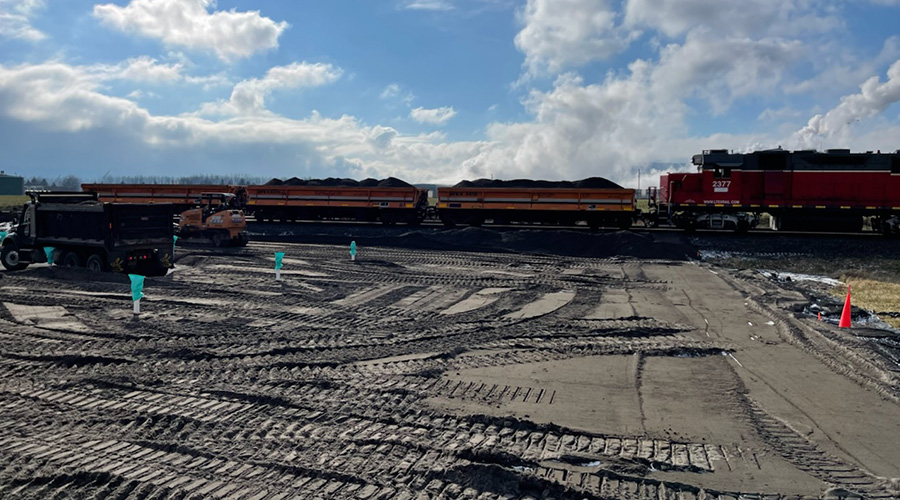Washington state port primed to start major rail expansion in 2024
1/25/2024
By Jeff Stagl, Managing Editor
This year could be a big one for the Port of Longview’s Industrial Rail Corridor Expansion (IRCE) project. In the planning stages for more than five years, the $85 million project is slated to make it through the final preparations stretch in 2024 and reach the construction stage by late summer.
The Washington state port is pursuing the multi-year expansion project to support current volume growth and a berth revitalization effort, attract additional cargo and accommodate full-length unit trains. Located on the Columbia River in southwest Washington near the Oregon border and 66 miles from the Pacific Ocean, the port is served by BNSF Railway Co. and Union Pacific Railroad.
To be completed by the end of 2027, the IRCE project calls for constructing a six-track rail bed adjacent to an existing rail corridor completed in 2004; adding two 8,500-foot tracks; and increasing the length of current tracks from 7,500 feet to 8,500 feet. In addition, the work involves new stormwater conveyance and treatment facilities, track operation systems, lighting, utility improvements and rail crew support facilities.
The new railway embankment will extend from east of a switching yard to a grade-separated crossing. Both BNSF and UP helped with the project’s design to ensure the rail infrastructure met Class I standards, says Port of Longview Marketing Communications Manager Ashley Helenberg. The design enables the port to add more tracks to the prepared rail bed if it requires more rail capacity.
“We’re only building two tracks in this first phase. The rail bed can hold six tracks,” Helenberg says. “As time goes on, we will add more tracks depending on growth and demand.”
 Located on the Columbia River in southwest Washington, the port operates an internal rail network that connects with BNSF Railway Co. and Union Pacific Railroad. Port of Longview
Located on the Columbia River in southwest Washington, the port operates an internal rail network that connects with BNSF Railway Co. and Union Pacific Railroad. Port of LongviewThe IRCE is designed to double freight capacity through the corridor, address current operational barriers, capitalize on the port’s geographic location and generate significant local economic benefits. The work is needed because of the expanding global marketplace and limited available rail infrastructure to meet demand, port officials say.
“The purpose of the project is to improve rail connectivity between [our] marine facilities on the Columbia River and the [BNSF/UP] mainline to the east to alleviate capacity constraints on the current rail system, provide adequate and efficient rail service to support rail demands of current tenants and customers, and prepare for projected growth,” they say in a project summary. “The project will reduce both train idling time and local rail traffic congestion.”
Since the initial industrial rail corridor became operational in January 2004, the port’s cargo tonnage has skyrocketed by more than 500%, mostly because of the development of a large EGT LLC export grain terminal that opened in 2011. In addition to grain, the port handles fertilizers, heavy-lift cargo, logs, lumber, minerals, paper, pulp, steel, wind energy components and other freight.
 The port needs to expand its rail corridor because of exploding cargo growth. Since the initial industrial rail corridor became operational in January 2004, cargo tonnage has skyrocketed more than 500%. Port of Longview
The port needs to expand its rail corridor because of exploding cargo growth. Since the initial industrial rail corridor became operational in January 2004, cargo tonnage has skyrocketed more than 500%. Port of LongviewSince the rail expansion is the port’s largest financial investment and biggest capital project since it was formed in 1927, port leaders have sought funding assistance from multiple sources, including federal, state and local agencies.
In 2021, the port landed a $16 million Rebuilding America’s Infrastructure with Sustainability and Equity — or RAISE — grant from the U.S. Department of Transportation (USDOT) for the work. Other grant awards include $2 million from Washington’s State Freight Rail Assistance Program and $2 million from Cowlitz County’s Rural Development Program.
The port expects revenue generated from operations to cover its direct investment in the project. The port obtained a loan/bond to cover property tax levies.
In terms of the federal environmental review process for the IRCE, two agencies late last year issued Findings of No Significant Impact (FONSI). The USDOT’s Maritime Administration signed off on a FONSI in October 2023 and the Federal Railroad Administration did the same in November 2023.
The port now is trying to complete right-of-way/land acquisitions and finish off other final planning aspects, says Helenberg. Port leaders are anxious to start construction after working through a number of challenges. A big one was determining the rail extension’s route through some privately owned property nearby.
“We went through several iterations before identifying the final route,” says Helenberg.


